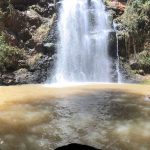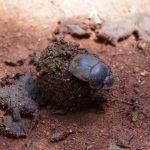Blog post by Katie, Quinn and Julia
You haven’t experienced bumpy roads until you’ve driven down the trail to Ndare Ngare Forest. Despite the upset stomachs endured on the way, today we had the amazing experience of visiting this community- and privately-owned conservancy. Ndare Ngare Forest is known for its spectacular view of Mt. Kenya, its abundant wildlife, and its refreshing waterfalls. As a community-owned conservancy, this forest is a key step in future conservation efforts because it allows wildlife and farmers to coexist in harmony.
Once we arrived at Ndare Ngare (which we learned was Swahili for “goat’s water”), we got to explore the forest through a canopy walk. We climbed to a dizzying height, level with the tree canopy, which allowed us to have a bird’s eye view and appreciate the vast biodiversity on the forest floor. As we walked along what appeared to be bridges made out of chicken wire, we caught glimpses of a flash of red, green, and black. It turns out, this was the exotic bird known as the Hartlaub’s Turaco (Tauraco hartlaubi), found only in East Africa. Turacos are named after the green pigment in their wings, turacoverdin. Despite being located in the canopies, Hartlaub’s Turaco only flies when necessary, and instead use their excellent climbing abilities to get around. However when they do fly, their brilliant crimson wings are visible. We also saw elephant skulls lying in the forest, and while we did not see live elephants, this does clearly reflect their presence in the forest. While traversing the chicken wire bridge, we also came across trees filled with what looked like spider webs. After consulting our guide, Daniel, we discovered that these “spider webs” were actually caterpillar nests that are only found in the moth tree. This moth tree is the perfect place to host caterpillar babies because the leaves are poisonous to other organisms, offering an important layer of protection from predators.
After exploring the forest canopy, our guides took us on a strenuous hike over difficult terrain with astonishing views of the Kenyan plains in the distance. Our destination was an effervescent waterfall, which was is a trademark of the forest. During the hike, the dung beetles feasting on rhino and cow poop was a fascinating diversion. When we finally made it to the waterfall, sweating and out of breath, many of us were tempted to go in for a dip. However, we did not bring our swimsuits and we found the pond already occupied – some British soldiers on their day off were bravely repelling down the waterfall. After enjoying our packed lunches, we started the trek back. Danya had a particularly painful trek back, showing off a behemoth blister by the time we reached the truck (see picture). We thanks our guide Danielle and armed game warden Alex and departed for our home base – Angiri Camp. Lily also had some excitement on the ride home when a weaver bird’s nest flew in through the window, right into her lap. Luckily, no baby birds were present.
We finished off the day with two oral presentations by Danya and Chloe about how humans have historically impacted different ecosystems in Africa. Both papers used paleolimnological and radiocarbon-dating approaches to quantify how ecosystems have changed over time with the advent of agriculture. Danya’s paper found that in southwestern Kenya, ecosystems have changed over time as human activity increased; however Chloe’s paper found that in a mountainous region in South Africa, ecosystems have remained relatively constant over five millennia even with human activity. The opposing results of these papers on two different regions gave us a valuable lesson about how the results of one study cannot be generalized to all situations, and we should always remain curious.
- Hannah at the waterfall
- Ngare Ndare Waterfall
- Danya’s blister
- Dung beetle rolling its ball of cow dung to lay eggs within.




Leave a Reply